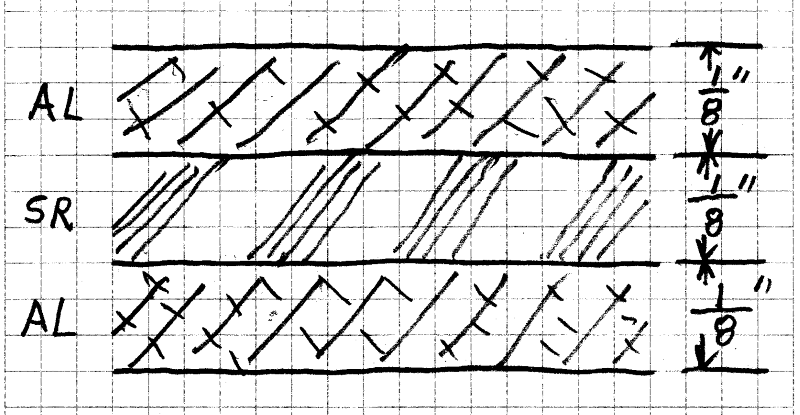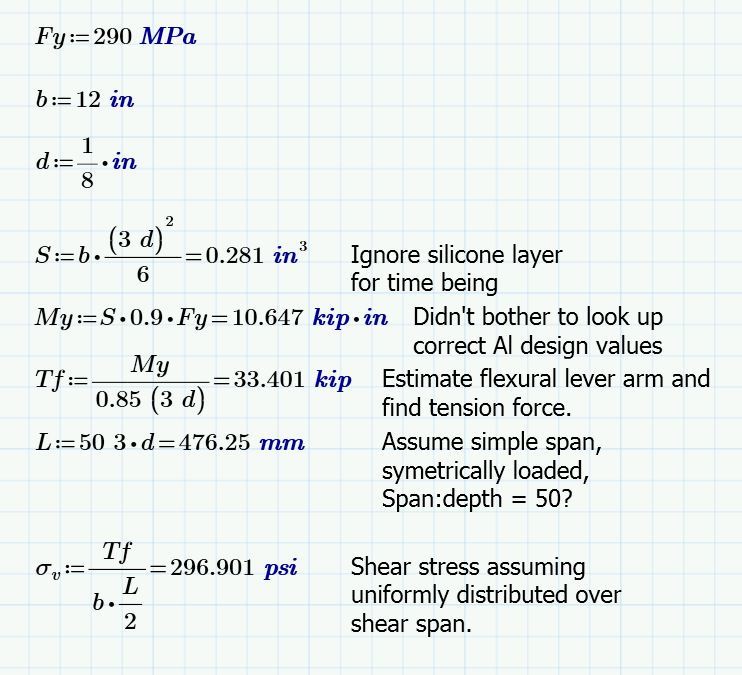Navigation
Install the app
How to install the app on iOS
Follow along with the video below to see how to install our site as a web app on your home screen.
Note: This feature may not be available in some browsers.
More options
-
Congratulations waross on being selected by the Tek-Tips community for having the most helpful posts in the forums last week. Way to Go!
You are using an out of date browser. It may not display this or other websites correctly.
You should upgrade or use an alternative browser.
You should upgrade or use an alternative browser.
Composite or laminated
- Thread starter Adamian
- Start date
- Status
- Not open for further replies.
Probably composite, paying homage to the strength and shear stiffness of the silicone layer. Treating it as non-composite would give you a simple upper bound estimate of course. But, then, in the real world, the loss of partially composite action is indicative of failure. Kinda depends on what you need from your answer.
I like to debate structural engineering theory -- a lot. If I challenge you on something, know that I'm doing so because I respect your opinion enough to either change it or adopt it.
I like to debate structural engineering theory -- a lot. If I challenge you on something, know that I'm doing so because I respect your opinion enough to either change it or adopt it.
- Thread starter
- #3
"composite or laminated", this thread's 'either - or' title, "composite or laminated", kinda confuses one....
...at least in my world, one 'laminates' in order to achieve 'composite' action, .... and the laminating connection must resist horizontal shears, that is the tendency of the individual laminates to slide past each other in the horizontal plane under loading, in order to be considered 'composite'. your 'way more elastic' connector won't accomplish compositeness.
...at least in my world, one 'laminates' in order to achieve 'composite' action, .... and the laminating connection must resist horizontal shears, that is the tendency of the individual laminates to slide past each other in the horizontal plane under loading, in order to be considered 'composite'. your 'way more elastic' connector won't accomplish compositeness.
- Thread starter
- #6
Gentlemen, I thank you for your contribution. Your input is highly appreciated.
Let me recap just to make sure that all of us are on the same page.
Two statements that have been advanced are:
1) the loss of partially composite action is indicative of failure
2) your 'way more elastic' connector won't accomplish compositeness
As part of my research I refer to MIT Open Course Structural Mechanics, Paragraph 7.5:
Link
It is stated that in sandwich plates the Young's modulus of the "core" material is usually two orders of magnitude smaller than that of the face plates. Now in my particular example I am dealing with aluminum plates and a silicone core, that have the following shear strengths:
Silicon - 100psi
Aluminum - 30000psi
Since this is a difference of a magnitude of two (as described above) then again should I consider my section as composite or independent layers ?
Let me recap just to make sure that all of us are on the same page.
Two statements that have been advanced are:
1) the loss of partially composite action is indicative of failure
2) your 'way more elastic' connector won't accomplish compositeness
As part of my research I refer to MIT Open Course Structural Mechanics, Paragraph 7.5:
Link
It is stated that in sandwich plates the Young's modulus of the "core" material is usually two orders of magnitude smaller than that of the face plates. Now in my particular example I am dealing with aluminum plates and a silicone core, that have the following shear strengths:
Silicon - 100psi
Aluminum - 30000psi
Since this is a difference of a magnitude of two (as described above) then again should I consider my section as composite or independent layers ?
mronlinetutor
Structural
it won't be too difficult to calculate both composite and non-composite sections. it's a good exercise. just take the smaller value as the governing stress.
CELinOttawa
Structural
Whoa now... That really depends on the Silicon. There are very much structural silicons used in load bearing glass applications...
OP said:Since this is a difference of a magnitude of two (as described above) then again should I consider my section as composite or independent layers ?
In the cited document, the disparity in moduli is presented as justification for ignoring the core contribution to flexural stiffness. It is not presented as justification for treating the face plates as acting non-compositely. In fact, EQ 7.49a, by it's form, assumes 100% composite behavior.
Without running any numbers, I suspect that you'll have a high degree of composite behavior here as well. While the disparity in modulii is a couple orders of magnitude, the shear stresses are also usually a couple of orders of magnitude less than your flexural stresses so those effects tend to balance out. To assess the situation simply, try this:
1) calc flexural deflection assuming composite behavior in the face plates.
2) calc shear deflection in the core with standard VL/AG techniques.
3) compare one and two to get a sense for how much shear deformation of the core matters.
Anecdotally, were composite behavior not achievable with disparite stiffness/strength materials, we would not have modern:
- skis
- airplane wings
- wind turbine blades.
I like to debate structural engineering theory -- a lot. If I challenge you on something, know that I'm doing so because I respect your opinion enough to either change it or adopt it.
But KootK, I would have thought that the adhesives in skis, aircraft, and turbine blades are something harder and stiffer than structural silicone. The shape of jointing is crucial with silicone, and a wider than deep joint is not supposed to work well.
You may be right. OP's doc mentioned foams with about the same moduli disparity as we've got here so I ran with that. Another thing that will factor in is that the core is relatively thin here compared to typical sandwich scenarios. I'm hoping that OP will step up and use the method that I mentioned previously to git quantitative on this.
I like to debate structural engineering theory -- a lot. If I challenge you on something, know that I'm doing so because I respect your opinion enough to either change it or adopt it.
I like to debate structural engineering theory -- a lot. If I challenge you on something, know that I'm doing so because I respect your opinion enough to either change it or adopt it.
hokie66 is correct. Silicone can indeed be structural; however, it has significantly different moduli (any of them...take your pick) than a metal. In that context, I would not consider this a composite section, but one of independent layers that happen to be attached.
Well this is similar to design of laminated glass panel
Two sheets of glass laminated together with PVB foil ( or similar)
In glass design it depends on the duration of the load
if the load is short, like wind, then the interlayer can take shear force and thus the section is a 'composite' section
if the load is longer, like snow or dead load, then the interlayer will creap and the system behaves like two separate glass panels
This is how glass design is done
Two sheets of glass laminated together with PVB foil ( or similar)
In glass design it depends on the duration of the load
if the load is short, like wind, then the interlayer can take shear force and thus the section is a 'composite' section
if the load is longer, like snow or dead load, then the interlayer will creap and the system behaves like two separate glass panels
This is how glass design is done
SlideRuleEra
Structural
Look at the proportions of the OP's question, each of the 3 layers is 1/8" thick:

This is not about the properties of silicone rubber as an adhesive. Is more about the structural properties of silicone rubber compared to structural properties of aluminum. Even if the silicone rubber is "perfectly" bonded to each of the aluminum sheets, I see this problem resembling a (hypothetical) beam where the flanges are metal and the web is rubber. IMHO, the silicone rubber layer is essentially structurally "worthless"... the two aluminum sheets are two independent layers, per comments given by others.
![[idea] [idea] [idea]](/data/assets/smilies/idea.gif)
![[r2d2] [r2d2] [r2d2]](/data/assets/smilies/r2d2.gif)
This is not about the properties of silicone rubber as an adhesive. Is more about the structural properties of silicone rubber compared to structural properties of aluminum. Even if the silicone rubber is "perfectly" bonded to each of the aluminum sheets, I see this problem resembling a (hypothetical) beam where the flanges are metal and the web is rubber. IMHO, the silicone rubber layer is essentially structurally "worthless"... the two aluminum sheets are two independent layers, per comments given by others.
![[idea] [idea] [idea]](/data/assets/smilies/idea.gif)
![[r2d2] [r2d2] [r2d2]](/data/assets/smilies/r2d2.gif)
EngineeringEric
Structural
Each AL takes 1/2 the load and is an independent layer unless there is sufficient shear flow.
Similar to 2-ply 2x8 wood headers loaded in the weak direction, is (6)10d nails sufficient to make it act as one single 3"x7.25"... no, it takes a lot of shear transfer to actually work. I doubt the bond strength of silicone to clean Alum. is sufficient. but again, this is something calculable.
Similar to 2-ply 2x8 wood headers loaded in the weak direction, is (6)10d nails sufficient to make it act as one single 3"x7.25"... no, it takes a lot of shear transfer to actually work. I doubt the bond strength of silicone to clean Alum. is sufficient. but again, this is something calculable.
I put some ballpark numbers to this assuming one would want to take the aluminum all the way to yield which is probable untrue. Lots of semi-valid approximations and no consideration for stiffness. It's fails but it's not like the shear stress is orders of magnitude out or anything compared to OP's allowables. Kinda depends on your expectation for the system. However, I'm used to working with silicone systems that give me ~20psi shear strength in SSG glazing applications.

I like to debate structural engineering theory -- a lot. If I challenge you on something, know that I'm doing so because I respect your opinion enough to either change it or adopt it.

I like to debate structural engineering theory -- a lot. If I challenge you on something, know that I'm doing so because I respect your opinion enough to either change it or adopt it.
- Thread starter
- #20
- Status
- Not open for further replies.
Similar threads
- Replies
- 2
- Views
- 15
- Question
- Replies
- 0
- Views
- 11
- Replies
- 10
- Views
- 28
- Question
- Replies
- 2
- Views
- 13
- Question
- Replies
- 12
- Views
- 474
